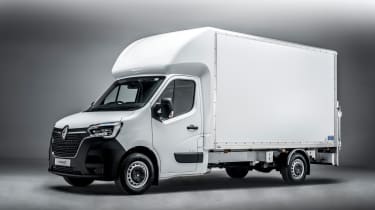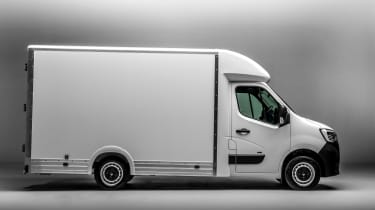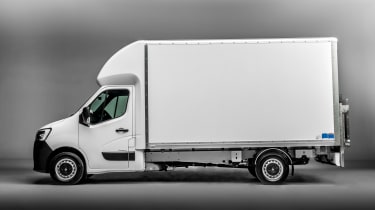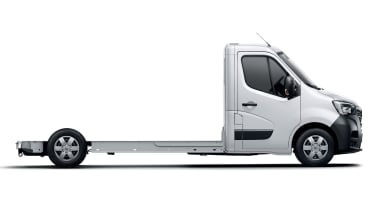All-electric Renault Master ZE van is now available in 3.5 tonne form in a variety of body styles
Renault has updated the Master ZE electric van range with new body styles and an increase in payload weight. The all-electric large van now has a maximum gross vehicle weight (GVW) of 3.5 tonnes (up from 3.1 tonnes), bringing it into line with the diesel Master van and increasing payloads by 375kg at the same time.
As well as the standard panel van and a platform cab variants, the Master ZE is now also offered as a chassis cab, ready for conversion, while Renault has also launched a Luton low-loader variant as part of its ‘Off The Shelf’ conversion range. The panel van comes in three lengths and two roof heights, while the Platform Cab and Chassis Cab are offered in two lengths.
The chassis cab can be converted into tipper, dropside or conventional Luton body styles by Renault’s list of approved conversion companies. These updates mean the Master ZE is the large electric van with the widest range of body styles on offer. The 3.1-tonne version of the Master ZE is still available alongside the 3.5 tonne version.
Best big panel vans 2020
Renault says the Master ZE has a “real-world” driving range of 75 miles from its 33kWh battery, and this is consistent across the range. Charging the Master ZE takes as little as six hours via a 7kW wallbox, and Renault offers charging options as part of the buying process.
Prices for the Renault Master ZE start from around £64,500, which includes the Government’s £8,000 Plug-in Van Grant. While that’s a lot more than the diesel Master, buyers will save hundreds in terms of everyday running costs and tax benefits, so the total cost of ownership (TCO) will be better.
Renault Master ZE: equipment and specs
The all-electric Renault Master ZE comes in Business spec, but adds some EV-specific kit, such as a pre-heating function and “ZE Voice”, which is a sound generator designed to warns pedestrians of the van’s presence at low speeds. Renault is also introducing a host of telematics and connectivity options with the Master ZE to keep fleet managers up to date with the status of their vans.
Renault’s panel van variant boasts a cargo volume of between nine and 13 cubic metres and a payload of 1,490kg, while the ‘Off The Shelf’ Luton Low-Loader offers up to 20 cubic metres of space and a one-tonne payload.
New Renault Master ZE: powertrain and performance
The Master ZE is powered by a 33kWh lithium-ion battery pack, which is mounted in the same location as the diesel-engined van’s gearbox. As such, the Master ZE has the same access height as the standard model, while the load volume is unchanged.
Power for the Master ZE comes from Renault’s R75 electric motor. The 76bhp unit is one previously offered in the Zoe supermini, so it should prove to be reliable for fleet users. It gives the Master ZE a top speed of either 62mph in the 3.1-tonne version or 50mph in the 3.5 tonne model, underlining Renault’s belief that this is a delivery van for the city, rather than long-distance work.
The powertrain is also fitted with a unique Eco mode – helping to deliver Renault’s claimed range of 75 miles. However, that figure will very much depend on the payload, weather and driving style.
As well as offering zero-emissions deliveries, the Master ZE introduces Renault’s next generation fleet management software. On-board telematics will allow fleet managers to monitor all vehicles via Renault’s EasyConnect software and check on vehicle location, mileage, range and nearby charging points.
Any technical issues that arise, such as flat tyres or repairs, can also be relayed back to the fleet manager. Finally, in an effort to streamline fleet maintenance, the system can send direct messages to a Renault Pro+ dealer if a van is due a service.
New Renault Master ZE driven
Like the smaller Kangoo ZE, the Master ZE fires up with a chime from the dashboard and a green ‘GO’ light in the middle of the speedometer. Put the van into drive from neutral (there’s no Park mode) press the accelerator, and the Master ZE creeps forward with the same ghostly hum from its ‘ZE Voice’ that you’ll hear from a Zoe or Kangoo ZE.
This artificial noise can be turned off, although it shuts off automatically at speeds over 30mph because, by then, the sound is drowned out by wind and tyre noise. However, you’d hardly call the Master ZE loud when on the move.
We tried the Master ZE van with a 400kg payload strapped into the back on a route that was representative of urban stop-start driving, which is the kind of driving the Master ZE is designed for. Unlike the smaller, lighter Kangoo, the Master ZE doesn’t have the instant kick of acceleration you normally get from an electric vehicle.
It accelerates as quickly as the diesel Master, though, easily managing to keep up with traffic. Rolling acceleration is decent, too, with a meaty amount of torque helping the Master accelerate from 30–50mph without too much drama. In Eco mode, though, acceleration is significantly blunted, but the van doesn’t feel hindered when climbing steep hills.
Unlike the Kangoo, the Master ZE is fairly refined on the move. You can hear stones and debris ping into the front wheel arches, but overall it’s pretty quiet, helped no end by the standard steel bulkhead that divides the cabin from the load area, which is where most of the Kangoo’s cabin noise comes from.
Our test route covered 43 miles in around two hours, and at the end of it there was still 50% charge left in the battery, so Renault’s claim of an everyday usable range of 74 miles seems entirely feasible.
A full charge of the battery takes six hours when using a 32 Amp/7.4kW wallbox (it’s a whopping 17 hours from flat via a standard mains plug), so it’s feasible for fleet users to have a fully charged fleet of vans ready to go overnight. It’s even possible to have vans on charge during the day while others are out on delivery.
Check out the best large panel vans you can buy today…
Source: Read Full Article



 Best big panel vans 2020
Best big panel vans 2020

